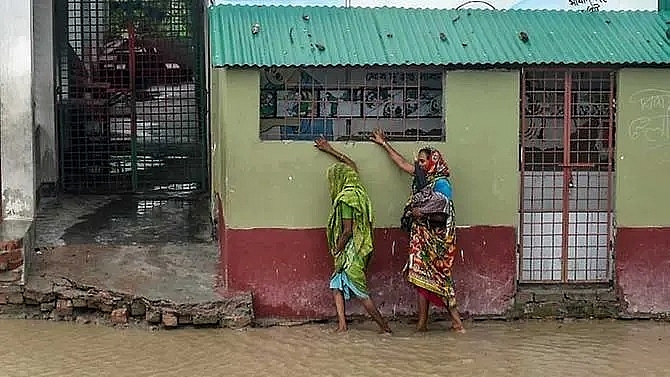'Super cyclone' Amphan batters Bangladesh and India
 |
| Residents walk along a house on a flooded street heading to a shelter ahead of the expected landfall of cyclone Amphan, in Dacope of Khulna district. (Munir uz Zaman/AFP) |
High winds and torrid rains pounded coastal villages and cities, bringing down power lines, uprooting trees and inundating homes.
"The situation is more worrying than the coronavirus pandemic. We don't know how to handle it," India's West Bengal state leader Mamata Banerjee told reporters late Wednesday.
"Almost everything is destroyed in the coastal villages of the state."
Authorities had scrambled to evacuate more than three million people from low-lying areas, but the task was complicated by the need to prevent the spread of coronavirus.
Cyclone Amphan is set to cut a devastating path through eastern India and Bangladesh
Cyclone Amphan is set to cut a devastating path through eastern India and neighbouring Bangladesh at a time when both countries are struggling to contain coronavirus outbreaks.(AFP/Munir Uz zaman)
In Bangladesh officials confirmed six deaths including a five-year-old boy and a 75-year-old man, both hit by falling trees, and a cyclone emergency volunteer who drowned.
Bangladesh meteorological department chief Shamsuddin Ahmed said the cyclone hit the southwestern coastal district of Satkhira with winds at 151 kilometres per hour.
Some three million people were left without power, Bangladesh officials said. Much of the impoverished nation of 168 million people was pounded by heavy rains.
Three other people died after being hit by uprooted trees in India's West Bengal, the state's disaster management minister Javed Khan told AFP.
Two other fatalities were reported by Indian media in Odisha state. AFP could not verify the deaths.
Some 224.6 millimetres of rain fell from early Wednesday and winds up to 113 kph lashed Kolkata, capital of West Bengal state and home to some 14.7 million people.
Some of the historic city was plunged into darkness as power lines were knocked out.
Video shared on social media showed electricity transformers sparking and exploding in the wild weather. Media reports said 5,500 houses were damaged in one West Bengal district.
The cyclone is expected to weaken as it moves north and northeast, and recede to a tropical depression by midday Thursday, the Indian Meteorological Department said.
STORM SURGES
Amphan is the first "super cyclone" to form over the Bay of Bengal since 1999, and packed winds gusting up to 185 kph.
It brought a storm surge - a wall of ocean water that is often one of the main killers in major weather systems - that roared inland for several kilometres, media reports said.
In southwestern Bangladesh, a five-feet-high storm surge broke an embankment and swamped a large area of farmland, a local police officer told AFP.
Bangladesh officials were particularly concerned about the damage to the Sunderbans, a UNESCO world heritage site famed for its mangrove forest and tiger population, which they said bore the brunt of the cyclone.
"We still haven't got the actual picture of the damage. We are particularly concerned over some wild animals. They can be washed away during storm surge in high tide," forest chief Moyeen Uddin Khan told AFP.
Houses "look like they have been run over by a bulldozer", said Babul Mondal, 35, a villager on the edge of the Indian side of the Sunderbans.
"Everything is destroyed."
Bangladesh's low-lying coast, home to 30 million people, and India's east are regularly battered by cyclones that have claimed the lives of hundreds of thousands of people in recent decades.
The 1999 super cyclone left nearly 10,000 dead in Odisha, eight years after a typhoon, tornadoes and flooding killed 139,000 in Bangladesh.
In 1970, half a million perished.
While the frequency and intensity of storms have increased - blamed partly on climate change - casualties have fallen thanks to faster evacuations, better technology and more shelters.
VIRUS COMPLICATIONS
Bangladesh authorities had feared Amphan will be the most powerful storm front since Cyclone Sidr killed about 3,500 people in 2007.
Enamur Rahman, Bangladesh's junior minister for disaster management, told AFP 2.4 million people and over half a million livestock were brought to shelters.
India evacuated more than 650,000 in West Bengal and Odisha.
Because of coronavirus, authorities used extra shelter space to reduce crowding, while making face masks compulsory and setting aside isolation rooms.
Infection numbers are still soaring in both countries.
Sulata Munda, a tribal villager in Bangladesh, said she and fellow villagers decided not to go to a shelter.
"We fear the cyclone, but we also fear the coronavirus," the mother of four told AFP.
Although outside Amphan's predicted path, there were fears for the almost one million Rohingya refugees in southeastern Bangladesh - most living in flimsy, makeshift shacks.
There were also concerns for hundreds of Rohingya thought to be out at sea in rickety boats and denied entry by Thailand and Malaysia in recent weeks because of coronavirus restrictions.
What the stars mean:
★ Poor ★ ★ Promising ★★★ Good ★★★★ Very good ★★★★★ Exceptional
Related Contents
Latest News
More News
- 72 nations sign landmark Hanoi cybercrime convention (October 26, 2025 | 18:00)
- UN Secretary-General commends Vietnam’s global leadership (October 26, 2025 | 09:00)
- APEC finance ministers convene to tackle regional challenges (October 22, 2025 | 17:31)
- Rewiring global trade: ASEAN’s rise as supply chain hub (October 17, 2025 | 11:40)
- Vietnam attends first World Nuclear Week Forum in Russia (September 26, 2025 | 10:50)
- Vietnam attends 69th session of IAEA General Conference (September 16, 2025 | 10:00)
- ADB, WB pledge over 12 billion USD for ASEAN power grid, renewable energy projects (August 15, 2025 | 14:18)
- Lowy Institute proposes AI-based tobacco control solutions for ASEAN (August 15, 2025 | 14:14)
- Cloud computing policy to position Malaysia as regional hub by 2030 (August 15, 2025 | 14:11)
- Thailand, Cambodia suffer numerous cyber attacks (August 05, 2025 | 16:19)

 Tag:
Tag:





















 Mobile Version
Mobile Version